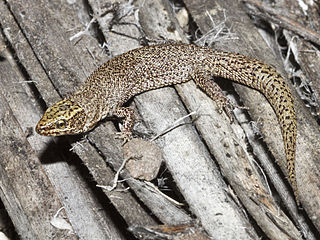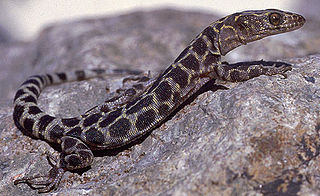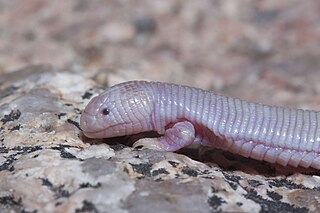
Xantusia () is one of three genera of night lizards. Species of Xantusia are small to medium-sized, viviparous (live-bearing) lizards found in the U.S. Southwest and in northern Mexico. These lizards display morphological adaptations to specific microhabitats. They occupy rock crevices and decaying plants. Rock dwellers generally have brighter coloration, longer limbs and digits, and larger size than plant dwellers, which are generally duller, smaller, and have shorter limbs.
Species of the genus Xantusia are remarkably disjunct, with populations scattered throughout the deserts and mountains of the far western borderlands with only a handful of recorded cases of interspecific allopatry. The genus contains at least seven distinct cases of morphological convergence to the rock dwelling ecomorph in Arizona, California, Baja California, and Central Mexico.

The southern alligator lizard is a common species of lizard in the family Anguidae. The species is native to the Pacific coast of North America. It ranges from Baja California to the state of Washington and lives in a variety of habitats including grasslands, chaparral, forests, and even urban areas. In dry climates, it is likely to be found in moist areas or near streams. There are five recognized subspecies.

The island night lizard is a species of night lizard native to three of the Channel Islands of California: San Nicolas Island, Santa Barbara Island, and San Clemente Island. A small number of island night lizards also live on Sutil Island, near Santa Barbara Island.

The western skink is a species of small, smooth-scaled lizard with relatively small limbs. It measures about 100 to 210 mm in total length. It is one of seven species of lizards in Canada. They spend much of their day basking in the sun. Their diet ranges widely, including spiders and beetles. Western skinks will bite if grasped and will flee if they feel threatened. It is a common but secretive species whose range extends from southern British Columbia and throughout Washington, Oregon, Nevada, Utah, Idaho, and Wyoming and into western Montana and northern Arizona and Missouri. They can also live in some areas of Texas It is widespread in northern California but primarily restricted to the coast in central and southern California. Found in a variety of habitats, this lizard is most common in early successional stages or open areas of late successional stages. Heavy brush and densely forested areas are generally avoided. Western skinks are found from sea level to at least 2,130 m (7,000 ft). This diurnal reptile is active during the warm seasons.

Plestiodon gilberti, commonly known as Gilbert's skink, is a species of heavy-bodied medium-sized lizard in the family Scincidae. The species is endemic to the southwestern United States, and grows to about 7 to 12 cm in total length.

Night lizards are a group of small scincomorph lizards, averaging from less than 4 cm (1.6 in) to over 12 cm (4.7 in) snout–vent length. Most species are viviparous (live-bearing), with the exception of those in the genus Cricosaura. The family has only three living genera, with approximately 34 living species. The genera are divided by geographic range: Xantusia in southwestern North America and Baja California, Cricosaura in Cuba, and Lepidophyma, the most populous night lizard genus, in Central America. Three fossil genera are also known: Catactegenys, Palepidophyma, Palaeoxantusia.

The desert night lizard is a night lizard native to the Southern California Eastern Sierra and the San Gabriel Mountains into Baja California, southern Nevada, southwestern Utah and extreme western areas of Arizona.

John Xantus de Vesey a.k.a. de Csíktaplócza was a Hungarian exile and zoologist. Xantus was born Xántus János, in Csokonya, Somogy, Hungary.

The western whiptail is a species of lizard in the family Teiidae. The species is found throughout most of the southwestern United States and northern Mexico. Most of its populations appear stable, and it is not listed as endangered in any of the states comprising its range. It lives in a wide variety of habitats, including deserts and semiarid shrubland, usually in areas with sparse vegetation; it also may be found in woodland, open dry forest, and riparian growth. It lives in burrows. Major differences between this species and the checkered whiptail include the lack of enlarged scales anterior to the gular fold and the presence of enlarged postantebrachial scales. It was previously known as Cnemidophorus tigris, until phylogenetic analyses concluded that the genus Cnemidophorus was polyphyletic. Since it does not migrate, a number of forms have developed in different regions, several of which have been given subspecific names – for example the California whiptail, Aspidoscelis tigris munda.

The granite night lizard is a species of xantusiid lizard endemic to North America.

The granite spiny lizard is a species of lizard in the family Phrynosomatidae.

Phyllodactylus xanti is a species of lizard in the family Phyllodactylidae. It is endemic to northwestern Mexico. It is also known as the leaf-toed gecko or Raza Island leaf-toed gecko when referring to the subspecies from the Isla Rasa; at present, there are altogether four recognized subspecies, while several more have been recognized previously.

Bezy's night lizard is a species of lizard in the family Xantusiidae. The species is endemic to Arizona.

The Mexican mole lizard, also commonly known as the five-toed worm lizard, or simply as Bipes, is a species of amphisbaenian in the family Bipedidae. The species is endemic to the Baja California Peninsula. It is one of four species of amphisbaenians that have legs.

Joseph Richard Slevin was an American herpetologist and the second curator of herpetology at the California Academy of Sciences, with which he was affiliated for over 50 years. He collected reptile and amphibian specimens from around the world, notably in the Galápagos Islands in a 17-month expedition, and was largely responsible for re-growing the academy's herpetological collection following its destruction in the 1906 San Francisco earthquake. He wrote or co-wrote nearly 60 scientific papers, and is commemorated in the scientific names of over a dozen species or subspecies of animals and plants.
The bolsón night lizard is a species of night lizard in the family Xantusiidae. The species, which was originally described by Robert G. Webb in 1970, is endemic to the state of Durango in Mexico. Not much is known about the lizard at present, as it appears to be simultaneously rare and rather secretive in nature.
Aspidoscelis danheimae, also known commonly as the Isla San José whiptail, the San Jose Island blue-throated whiptail, and el huico de la Isla San José in Spanish, is a species of lizard in the family Teiidae. The species is endemic to Isla San José in Baja California Sur, Mexico.
Xantusia jaycolei is a species of lizard in the family Xantusiidae. The species is native to Mexico.
Xantusia sherbrookei is a species of lizard in the family Xantusiidae. It is a small lizard found in the Baja California Peninsula of Mexico.
Xantusia wigginsi, Wiggins's desert night lizard, is a species of lizard in the family Xantusiidae. It is a small lizard found in California and Mexico.













